There’s something about endlessly browsing Pinterest for latest bath décor trends, even if you’re not planning on remodeling soon, but just the satisfaction of looking at a monochromatic, minimalistic bathroom with a curbless, rain head shower does something to my chilly little heart.
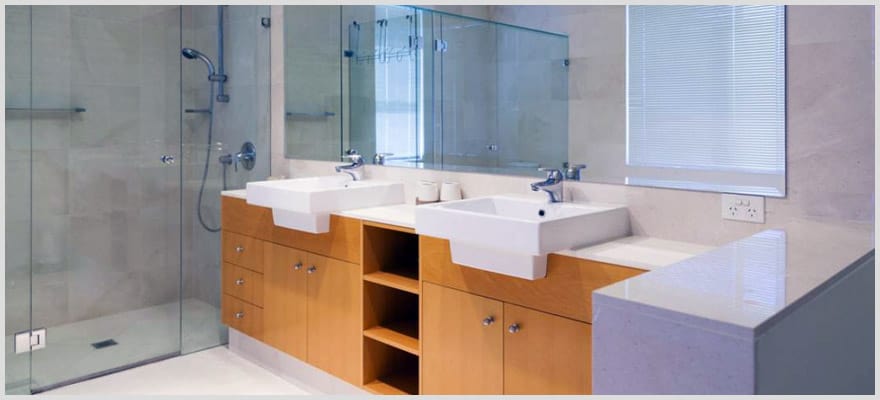
The latest craze in the bath décor trends is the appropriately titled curbless shower. The reason it’s called a curbless shower is that it gets rid off that one ugly step that you have in your bathroom that divides the shower area (even in a walk-in shower) from the rest of your bathroom.
This single step might make all the difference in your bathroom to get that spa-like treatment in your home.
While curbless showers might surely be visually appealing to you, they have many practical features.
What Is A Curbless Walk-In Shower?
Slowly but surely, people are moving away from traditional bathroom designs with bulky bathtubs and clunky, uneven bathroom flooring.
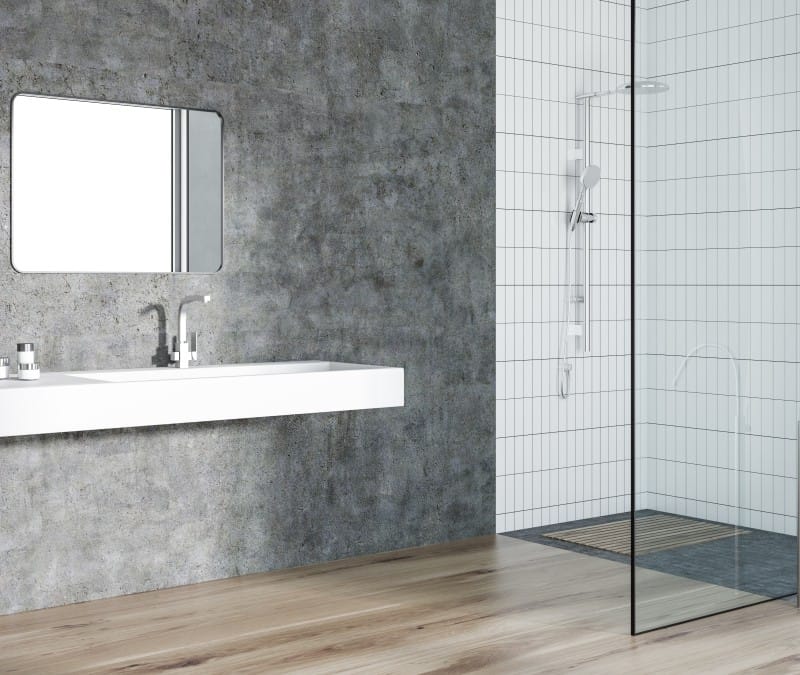
Modern designs sway more toward sleeker and cleaner lines with a more minimalistic approach to design. Curbless showers are very much on the path of modernistic architecture and design.
Traditional walk-in showers have a curb or a barrier that divides them from the rest of the bathroom and prevent water from getting all over the floor.
A curbless shower is essentially the same thing just without the curb, hence, the name. These kinds of showers give the bathroom a seamless look, but do require more space than traditional showers.
That is because the shower needs enough space for water to be contained or then it will splash all over the bathroom. In a smaller space, the design of the entire bathroom needs to be at a slight tilt to push the water toward the drain.
Curbless showers not only look great, but they are also a lot more accessible, meaning they prevent bathroom accidents like tripping over the curb while getting in and out of the shower.
They are also a lot easier to clean because they don’t have small hard to reach corners like traditional showers or bathtubs.
Pros of Curbless Showers
Cleanliness
We are completely aware of the disgusting slimy filth that accumulates near your shower step that nobody wants to clean.
A curbless shower indeed makes the case of good hygiene practices. The curbless shower makes it easier to clean your entire bathroom floor in one go without having to clean a small area of the bathroom while banging your elbows here and there.
Accessibility
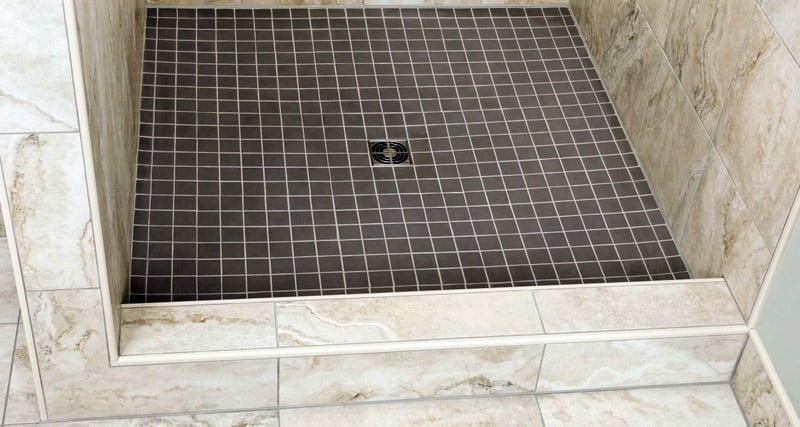
The shower, without any hurdle, is completely practical for members of all ages in your household. From a kid to a grandparent or anyone that might be visiting you, these showers eliminate the need for you to step over a hurdle early in the morning (like the picture above) without that strong cup of coffee.
A curbless shower might even seem like a very sensible idea if you have anyone in your family with some form of disability.
Here is a video how to build a walk-in (curbless) shower:
Keeps Your Bathroom Dry
This might come as a surprise but curbless showers are designed to keep a majority of the portion of your bathroom dry.
These bathrooms are sloped towards the drain which encourages water to travel towards your drain. The smarter positioning of the shower head and accurately sloping your bathroom floor towards the drain is all it takes to maximize the efficiency of curbless showers.
Luxurious
One of the benefits of getting a curbless shower has to be the kind of luxury it adds to a simple bathroom.
The interior doesn’t necessarily have to be top of the line for your bathroom to look like one of those bathrooms from House Hunters. Just a simple decision of going curbless can remove all barriers in your bathroom making it look wide and spacious.
It’s true that a curbless shower doesn’t always have to be one without a glass door, however, there are a few variations depending upon what kind you would prefer along with how much you’re willing to invest in remodeling and decorating your bathroom.
Cons of Curbless Showers
Keeping in mind these aforementioned factors that make an appealing case for the curbless shower, you might want to examine the following before installing one.
Privacy
Privacy can be a key factor if you have people traipsing into your bathroom while you’re taking a shower.
A shower curtain or door might make the entire point of a curbless shower moot, so if you’ve got that kind of a family then maybe installing a curbless shower might not be the wisest decision (or just start locking the door).
Heat
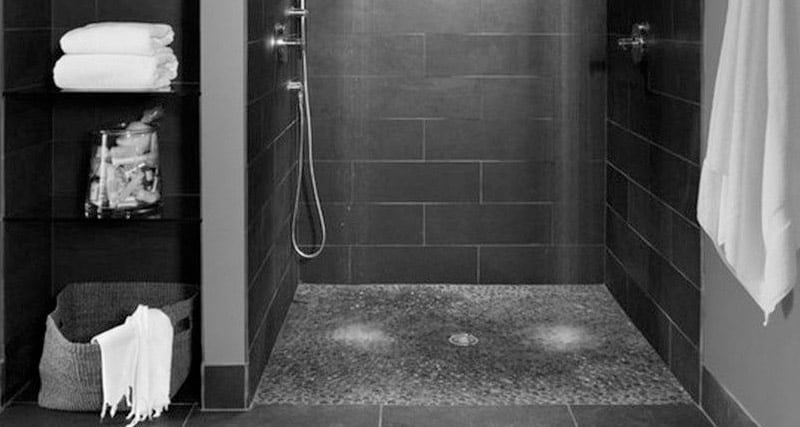
This is one of the drawbacks that actually concerns me. Without a shower door, a lot of the hot water might not seem as hot because of the openness of a curbless shower and in states where temperatures can drop quite low, I would be reluctant to drop the towel myself, to say the least.
Water Leakage
Despite of your contractor’s best efforts of making sure the slope of your bathroom floor is perfectly right to dispose off that extra water, some water might always get out of the splash zone and if that is a major cause of concern for you, then sadly, you might have to say goodbye to your dreams of getting that aesthetically pleasing bathroom.
Do not get me wrong, I am an avid fan of curbless showers. They unquestionably add a flare to your bathroom in the most minimalist way. Keep in mind that draining the water properly is the key element of the curbless shower.
Tips on How to Build a Curbless Shower
We suggest getting a contractor and professionals to come in and build you a curbless shower. They have the professional knowledge and expertise to do it correctly and make sure everything is working for you properly at the end. However, if you want to DIY it, there are ways to do that as well.
Manufacturers realized the love of DIY and provide curbless bathroom units as an entire system so you can install it with ease and minimal blunders.
These systems come with prefabricated trays that provide the sloping necessary for you, so you don’t have to lower or raise your floor yourself. These shower systems are also waterproofed so you don’t have to worry about that either.
These systems come with comprehensive instructions but do require some extra materials for you to get on your own like a plywood or OSB subfloor that needs to be leveled beforehand.
You might need to get the help of a professional to ensure that this is done properly so the structural integrity of the bathroom is not compromised.
Once that is done, you can go about installing the system as instructed and then weigh it down with a stack of tiles to set it in place.
Once it is set, you can start the tile installation, making sure you seal the area where the slope meets the rest of the bathroom.
Are Curbless Showers More Expensive?
Curbless showers are a little more technical than their curbed counterparts. They need to be sloped and installed correctly because they require special drainage.
If the drainage system is not installed properly, it can lead to problems because of moisture retention later on. These type of showers also require proper waterproofing of the floors and walls in the shower for the same reason.
All these reasons are factors in the cost of curbless showers; they are a lot more labor-intensive and also require more materials so the cost can run up.
A traditional curbed shower can cost anywhere from $2500 to $5000 total depending on the size and materials used.
A curbless shower can cost an additional $500 to $700 more. However, people who do get the curbless shower installed, think the slight cost difference is worth it in the long run.
How Much Space Is Needed For A Curbless Shower?
A curbless shower needs to have a gradually sloped floor to make sure that it is draining properly. To effectively make this slope the bathroom needs to have ample space.
If the bathroom is too small, the slope will be too drastic, making the shower design ineffective. The ideal depth for a curbless shower is anywhere between 42” to 48”, but the minimum depth is 36”.
If your bathroom is too small to accommodate this dept gradually, a curbless shower is probably not the best option for you; the slope needs to gradually slant at 1/8” to 3/6” per foot.
Does A Walk In Shower Need A Door?
The great thing about a curbless shower is its seamless design and minimalistic look. You can enhance this seamless look by removing the shower door.
A curbless shower without a door works best in a bigger space. The reason is a door-less shower needs to contain the splash from the water in the waterproofed area. It is also preferable to have the showerhead fixed and tilted toward the drain so the water can flow there effectively.
Is a Curbless Shower Worth it?
Given the right design for your bathroom space, a curbless shower can be an excellent choice for many homeowners.
While it has its share of negatives, the positives outweigh them, especially for elder people.
One is the ease of going in and out of the area. Without a barrier, you prevent tripping, which is very important since many accidents happen inside a bathroom.
Both young and the elderly would be equally vulnerable to this potential hazard since it’s easy to forget it’s there, especially when one is in a hurry.
Curbless showers are versatile and make for a more open appearance with a smaller space.
Being curbless also becomes much easier to clean since you don’t have the usual shower curtain that typically goes with a shower enclosure where mold and mildew love to thrive.
Overall, your bathroom looks seamless and more appealing with decorative tiles that go on full display with a curbless design.
How do you Keep Water in a Curbless Shower?
Some homeowners might be concerned with water flooding in the entire bathroom since no threshold would contain flowing water from the shower area.
On the contrary, this issue is avoidable with the appropriate design and installation. While it is curbless, you can keep water from overflowing to the rest of your bathroom by positioning your shower head towards a sloping drain.
It should solve any concerns about water spilling over to the adjacent toilet or bathroom spot. However, if you don’t have lower profile drainage, you may consider a rubber threshold that will collapse or flatten when stepped on.
Another alternative that could work if it’s a new build would be to install a trench drain opposite the shower or beside the shower boundary. It has a channel shape that facilitates surface water flushing with its linear grate on top.
What is a Curbless Shower Pan?
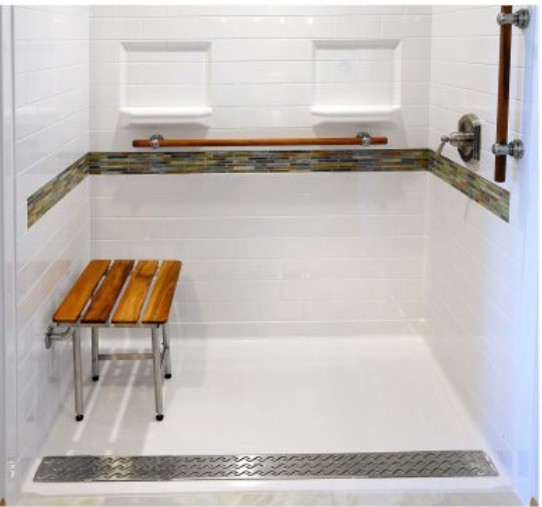
A curbless shower pan is a ready-made structure that forms part of your shower floor, steering water to the drain.
It has a downward slope at a minimum quarter inch that allows excess shower water to slide towards the drain ensuring proper drainage, yet has no borders, which makes for a seamless look. Think funnel but with a much wider top body.
Given its pre-formed setup, it is used in place of a conventional mortar bed, constructed from scratch using a mud mixture that can take longer to accomplish.
In any case, curbless shower pans can support the weight of users and protect the underlying layer from water damage.
Although it works alongside curbless showers and trench drains, it can also fit shower designs with very low entry borders.
How Much Slope Should a Curbless Shower Have?
One of the most crucial designs of a curbless shower is its slope. Without it, an even-leveled surface will cause water buildup that could give rise to other issues such as mold and mildew.
According to the International Plumbing Code (IPC), a curbless shower floor should have a minimum slope of 0.25 inches per running foot to effectively direct water to the drain. It slants inward at a 5-degree angle. With a traditional shower design, such a slope is factored in the mortar bed.
Meanwhile, the maximum slope possible is set at 0.5 inches for every 12 inches of horizontal run. You will need to measure the length between the drain and the end of the furthest wall.
Multiply the figure with 0.25 to get the actual slope for your curbless shower. So if the distance, for example, is 3 feet, the slope you will apply should be 0.75 inches.
Where Does the Linear Drain go in a Curbless Shower?
A linear drain is often preferred for its superior, efficient, and hygienic water egress, making it an excellent choice for curbless showers.
The elongated shape allows it to capture more water from the shower basin at a time and funnel it towards the exit port. So, where do you place it in a curbless shower?
Typically it goes where the lowest point of the surface from a slope is. That place would be parallel to the opposite wall where the shower head is directed.
It can extend along the entire length of the wall, which helps reduce water pooling or overflowing. However, many prefer the shower entry as a good linear drain location.
Aside from entailing a much easier install since it doesn’t require a recessed subfloor, it offers a better flow rate capacity of 5 gallons per minute.
On the other hand, you should never consider placing the linear drain at a position perpendicular to the shower entry, as it would result in an uneven surface that can be unsafe.
Do Curbless Showers Leak?
The answer is no if your curbless shower was designed and installed correctly. To ensure a leak-free curbless shower, it is important to cover this wet area with at least 95% mortar or an appropriately sized shower pan.
Otherwise, water will only accumulate in void spots that, when left unchecked, will cause the mortar and grout to weaken their bond.
Aside from this potential disaster, mold and mildew will likely grow beneath the tiles and along the grout lines.
Installers must seal all joints between the walls and floors and construct a waterproofing layer that will ensure there will be no leakage in the area, whether below or next to it.
How do Curbless Showers Work?
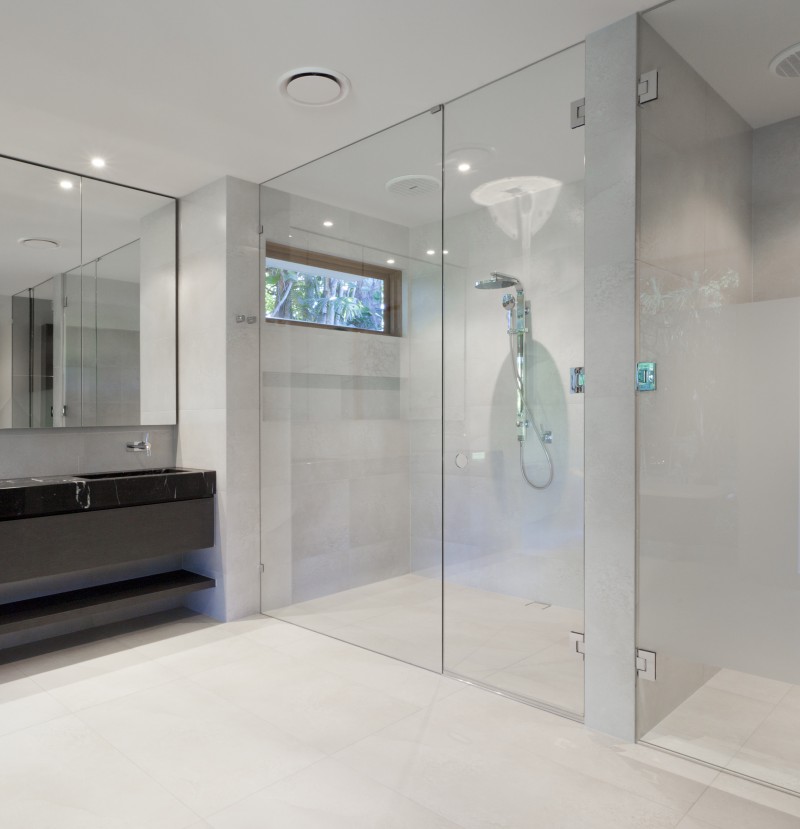
Curbless showers work by doing away with conventional borders at the base, which makes for its open layout, allowing you to walk into it without any obstruction.
It typically leaves you with a minimalist design consisting of a shower stall, shower head, and tile coverage, providing the appearance of a large space.
Despite the lack of barriers, a curbless shower will not cause water flooding or spilling over to surrounding areas, given its sloping surface that leads water towards the drain.
Many modern homes carry this curbless design in their bathrooms as it exudes class and elegance, especially when glass walls are employed.
Final Words
Consulting a few contractors before-hand and doing your due-diligence will make the installation process easier. While installing a curbless shower will most definitely require a good amount of planning, the end product will be absolutely worth it.
Related Posts
- Comparison of Matte vs Glossy Bathroom Tiles (with Photos)
- 14 Types of Bathtubs for your Home with Pros & Cons (Pictures)
- Best Wall Tile Backer Board Types and Brands for Bathroom Shower
- Bathroom DIY Designs and Ideas for Your Home
- 11 Different Types of Shower Heads for your Bathroom
- 10 Best Shower Wall Options & Materials for your Bathroom
Is it possible to make a curb less shower using a poured concrete floor? Thanks
Denise, yes you can. Have a look at a couple of videos below:
https://www.youtube.com/watch?v=jD7RXFugbSE
https://www.youtube.com/watch?v=W21I0pg_kPY
Glenn
So if I dont want water escaping, the best option is a curbed shower? My husband has Parkinsons disease and we wanted to avoid that small extra step up…..
Thanks!
Mary, you can have a curbless shower with a door that closes with a minimal gap with the floor. This will limit water escaping.
Do you know how to find someone in US who can do a retrofit from a fiberglass shower pan to curbless?
Hi, you can try Angi service or something similar.